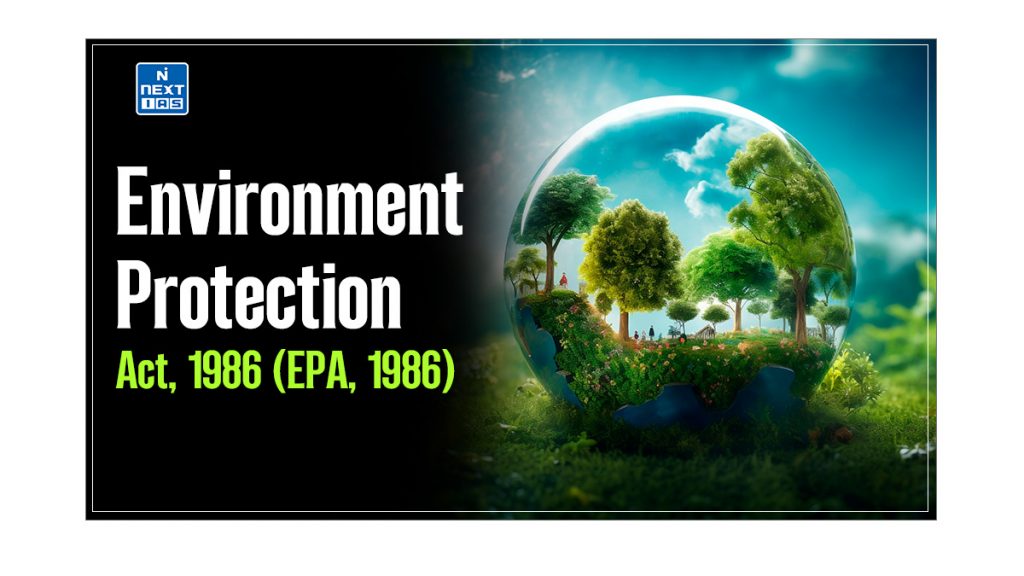
The Environment Protection Act, 1986 (EPA, 1986) is one of India’s most significant environmental legislation. Aimed at conserving the country’s environment and ecology, the Act marked a crucial turning point in the country’s approach to environmental conservation. This article aims to study in detail the Environment Protection Act, 1986 (EPA, 1986), its key provisions, implementation, challenges faced, and amendments made.
About Environment Protection Act, 1986 (EPA, 1986)
The Environment Protection Act, 1986 (EPA, 1986) is an umbrella legislation under which various rules and notifications have been framed and issued to take care of the different dimensions of environmental challenges.
Environment Protection Act, 1986: Historical Background
- Prior to the enactment of the Environment Protection Act, 1986 (EPA, 1986), there existed many laws in silos like The Indian Penal Code, The Criminal Procedure Code, The Factories Act, The Indian Forest Act, The Merchant Shipping Act, etc to deal with environmental concern.
- However, they lacked a focused approach.
- After the Stockholm Conference on Human Environment in June 1972, it was deemed necessary to have uniform laws all over the country for broad environmental problems endangering the health and safety of our people as well as of our flora and fauna.
- India is the first country which has made provisions for the protection and improvement of the environment in its Constitution.
- The 42nd Constitutional Amendment Act, 1976 inserted a new DPSP under Article 48-A, which enjoins the State to make endeavors for protection and improvement of the environment and for safeguarding the forest and wildlife of the country.
- The 42nd Constitutional Amendment Act, 1976 also inserted a new Fundamental Duty under Article 51-A (g), which stipulates that it shall be the duty of every citizen of India ‘to protect and improve the natural environment including forests, lakes, rivers and wildlife and to have compassion for living creatures’.
- The Water (Prevention and Control of Pollution) Act and the Air (Prevention and Control of Pollution) Act (both came into force before EPA 1986) were designed to deal with only water and air pollution problems.
- It was in the year 1986 that the Parliament enacted a comprehensive or umbrella legislation – the Environment (Protection) Act, 1986 – for environment in its entirety.
| Note: The Environment Protection Act, 1986 (EPA 1986) was enacted under the provisions of Article 253 of the Constitution, which seeks to supplement the existing laws on the control of pollution by enacting general legislation for environmental protection and to fill the gaps in regulations of major environmental hazards. |
Objectives of Environment Protection Act, 1986
- Creation of authorities with adequate powers for environmental protection
- Co-ordination of the activities of the various regulatory agencies
- Regulation of discharge of environmental pollutants and handling of hazardous substances
- Speedy response in the event of accidents threatening the environment and Provision for deterrent punishments
Features of Environment Protection Act, 1986
- The act empowers the central Government with all the power to take all such measures as it deems necessary or expedient for the purpose of:
- protecting and improving the quality of the environment and
- preventing controlling and abating environmental pollution, which includes setting new national standards for the quality of the environment (ambient standards) as well as standards for controlling emissions and effluent discharges;
- regulating industrial locations,
- prescribing procedures for managing hazardous substances;
- establishing safeguards to prevent accidents and collecting and dismantling information regarding environmental pollution.
- The responsibility for implementation of provisions of the Environment (Protection) Act has to a large extent, been entrusted to the same regulatory agencies created under the Water (Prevention and Control of Pollution) Act, 1974.
- Other agencies besides the Central and State Governments are also entrusted with the responsibility of implementing specific provisions of this Act and the Rules made there depending on their operational requirements.
- Under the act, the Central Government was also empowered including the power of entry for examination, testing of equipment and other purposes and power to analyze the sample of air, water, soil or any other substance from any place.
- There is also a specific prohibition on handling hazardous substances except those in compliance with regulatory standards and procedures.
- The act also provides for penalties for violating the provisions of the act. Any person who fails to comply with the Act shall be punished with a prison term of up to five years or fine up to Rs. 1 lakh, or both.
- The act also has innovative provisions for its enforcement, which was not present in any other pollution control legislation at that time.
- It provides that in addition to authorised Government officials, any person may file a complaint with a court, alleging an offence under the Act.
- Every rule made under this Act shall be laid, as soon as may be after it is made, before each House of Parliament.
Effectiveness of Environment Protection Act, 1986
- The Act gives the central Government a sweeping power to conserve the environment. But today we see our rivers turned into open sewers in many places and air is badly polluted which shows that there are many issues with the Act.
- The Act provides for the collection and dissemination of information regarding environmental pollution, which the Government has failed to do so. In its absence, a community may not be aware that a potentially hazardous operation is situated in its midst.
- Further, the Act gives the public significant powers to enforce the Act, but only Government officials are given the power under the Act to collect samples needed as evidence of violation of the Act.
- All the issues like the comparative late rollout of better emission control norms for fuels, failure to develop a mass transport system, failure to control river pollution, Inefficient and insufficient effluent treatment plants etc., among others, have led to the present situation.
Environment (Protection) Amendment Rules, 2021
MoEF has proposed amendments in the Environment Protection Act, 1986 (EPA 1986) to decriminalise some provisions.
Present Clause in EPA, 1986
- The Environment Protection Act currently says that violators will be punishable with imprisonment up to five years or with a fine up to Rs 1 lakh, or with both.
- Were violations to continue, an additional fine of up to Rs 5,000 would be levied for every day during which such failure or contravention continues after the conviction.
- There’s also a provision to extend jail terms upto seven years.
Proposed Changes in Amendment Rules, 2021
- The clause provides for the replacement of imprisonment with one that only requires them to pay a fine.
- The proposed fines, in lieu of imprisonment, are 5-500 times greater than those currently levied.
- In case of violations of the Act, the penalties could extend to anywhere from Rs 5 lakh to Rs 5 crore.
- Serious violations, which lead to grievous injury or loss of life, shall be covered under the provision of Indian Penal Code, 1860 read with Section 24 of EP Act.
- The removal of prison terms also applies to the Air Act and the Water Act.
- Appointing an “adjudication officer” who would decide on a penalty in cases of environmental violations such as information not provided when demanded or reports not being submitted.
- Funds collected as penalties would be accrued in an “Environmental Protection Fund”.
Way Ahead
- Respective governments can further make new and improved guidelines and policies regarding the implementation of environmental management systems.
- Governments can develop guidelines for companies regarding the process of environmental protection management and reporting.
- Strict rules should be made regarding a person and company who does not follow guidelines properly.
- Introducing and promoting the 3 R’s – Reduce, reuse, and recycle.
Conclusion
The Environment Protection Act, 1986 (EPA, 1986) is a cornerstone of India’s conservation efforts. By addressing its challenges and building upon its successes, India can continue to protect its environment and ecology.
Frequently Asked Questions (FAQs)
What is the purpose of the Environment Protection Act 1986?
The purpose of the Environment Protection Act of 1986 is to provide a framework for the protection and improvement of the environment in India.
Is the Environment Protection Act 1986 considered an Umbrella Act in India?
Yes, the Environment Protection Act, 1986 (EPA, 1986) serves as an umbrella legislation under which various rules and notifications have been framed to tackle different dimensions of environmental challenges.






